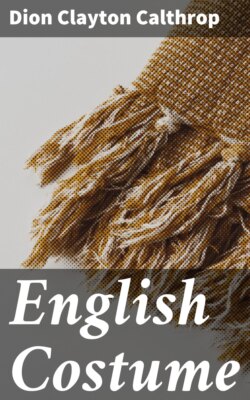Читать книгу English Costume - Dion Clayton Calthrop - Страница 21
На сайте Литреса книга снята с продажи.
THE MEN
ОглавлениеTable of Contents
The King himself is described as being careless of dress, chatty, outspoken. His hair was close-cropped, his neck was thick, and his eyes were prominent; his cheek-bones were high, and his lips coarse.
The costume of this reign was very plain in design, but rich in stuffs. Gilt spurs were attached to the boots by red leather straps, gloves were worn with jewels in the backs of them, and the mantles seem to have been ornamented with designs.
A MAN OF THE TIME OF HENRY II. (1154-1189)
He wears the short cloak, and his long tunic is held by a brooch at the neck and is girdled by a long-tongued belt. There are gloves on his hands.
The time of patterns upon clothes began. The patterns were simple, as crescents, lozenges, stars.
William de Magna Villa had come back from the Holy Land with a new fabric, a precious silk called ‘imperial,’ which was made in a workshop patronized by the Byzantine Emperors.
The long tunic and the short supertunic were still worn, but these were not so frequently split up at the side.
High boots reaching to the calf of the leg were in common use.
That part of the hood which fell upon the shoulders was now cut in a neat pattern round the edge.
Silks, into which gold thread was sewn or woven, made fine clothes, and cloth cloaks lined with expensive furs, even to the cost of a thousand pounds of our money, were worn.
The loose trouser was going out altogether, and in its stead the hose were made to fit more closely to the leg, and were all of gay colours; they were gartered with gold bands crossed, the ends of which had tassels, which hung down when the garter was crossed and tied about the knee.
Henry, despite his own careless appearance, was nicknamed Court Manteau, or Short Mantle, on account of a short cloak or mantle he is supposed to have brought into fashion.
The shirts of the men, which showed at the opening of the tunic, were buttoned with small gold buttons or studs of gold sewn into the linen.
The initial difference in this reign was the more usual occurrence of patterns in diaper upon the clothes.
The length of a yard was fixed by the length of the King’s arm.
With the few exceptions mentioned, the costume is the same as in the time of Stephen.
It is curious to note what scraps of pleasant gossip come to us from these early times: St. Thomas à Becket dining off a pheasant the day before his martyrdom; the angry King calling to his knights, ‘How a fellow that hath eaten my bread, a beggar that first came to my Court on a lame horse, dares to insult his King and the Royal Family, and tread upon my whole kingdom, and not one of the cowards I nourish at my table, not one will deliver me of this turbulent priest!’—the veins no doubt swelling on his bull-like neck, the prominent eyes bloodshot with temper, the result of that angry speech, to end in the King’s public penance before the martyr’s tomb.
Picture the scene at Canterbury on August 23, 1179, when Louis VII., King of France, dressed in the manner and habit of a pilgrim, came to the shrine and offered there his cup of gold and a royal precious stone, and vowed a gift of a hundred hogsheads of wine as a yearly rental to the convent.
A common sight in London streets at this time was a tin medal of St. Thomas hung about the necks of the pilgrims.
And here I cannot help but give another picture. Henry II., passing through Wales on his way to Ireland in 1172, hears the exploits of King Arthur which are sung to him by the Welsh bards. In this song the bards mention the place of King Arthur’s burial, at Glastonbury Abbey in the churchyard. When Henry comes back from Ireland he visits the Abbot of Glastonbury, and repeats to him the story of King Arthur’s tomb.
One can picture the search: the King talking eagerly to the Abbot; the monks or lay-brothers digging in the place indicated by the words of the song; the knights in armour, their mantles wrapped about them, standing by.
Then, as the monks search 7 feet below the surface, a spade rings upon stone. Picture the interest, the excitement of these antiquarians. It is a broad stone which is uncovered, and upon it is a thin leaden plate in the form of a corpse, bearing the inscription:
‘HIC JACET SEPULTUS INCLYTUS REX ARTURIUS IN INSULA AVALONIA.’
They draw up this great stone, and with greedy eyes read the inscription. The monks continue to dig. Presently, at the depth of 16 feet, they find the trunk of a tree, and in its hollowed shape lie Arthur and his Queen—Arthur and Guinevere, two names which to us now are part of England, part of ourselves, as much as our patron St. George.
Here they lie upon the turf, and all the party gaze on their remains. The skull of Arthur is covered with wounds; his bones are enormous. The Queen’s body is in a good state of preservation, and her hair is neatly plaited, and is of the colour of gold. Suddenly she falls to dust.
They bury them again with great care. So lay our national hero since he died at the Battle of Camlan in Cornwall in the year 542, and after death was conveyed by sea to Glastonbury, and all traces of his burial-place lost except in the songs of the people until such day as Henry found him and his Queen.
